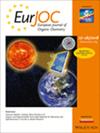1,3-二氮杂苷-2- one: Aza-β-内酰胺家族的合成方法和治疗前景
IF 2.7
3区 化学
Q2 CHEMISTRY, ORGANIC
引用次数: 0
摘要
1,3-二氮杂丁-2-酮是aza-β-内酰胺家族中被忽视的成员,是一种结构独特的四元含氮杂环化合物,在药物化学方面具有很强的潜力,特别是作为β-内酰胺酶抑制剂和抗生素类似物。本文综述了它们的合成、结构多样性及其生物学意义。最成熟的合成方法是C -本文章由计算机程序翻译,如有差异,请以英文原文为准。

1,3-Diazetidin-2-Ones: Synthetic Approaches and Therapeutic Promise within the Aza-β-Lactam Family
1,3-diazetidin-2-ones, overlooked members of the aza-β-lactam family, are structurally distinct four-membered nitrogen-containing heterocycles with strong potential in medicinal chemistry, particularly as β-lactamase inhibitors and antibiotic analogues. This review provides a comprehensive overview of their synthesis, structural diversity, and biological significance. The most established synthetic method is the [2 + 2] cycloaddition between CN nucleophiles and isocyanates, though this approach is highly substrate dependent and frequently leads to side products or cycloreversion. Alternative strategies—including photochemical and organometallic methodologies—have been explored but remain limited in scope. As a result, access to 1,3-diazetidin-2-ones is significantly constrained, impeding wider investigation and application. In silico studies suggest favorable stability and reactivity profiles and indicate these compounds could circumvent β-lactam resistance through hydrolysis-resistant enzyme intermediates. Several derivatives have demonstrated promising antibacterial, antifungal, antioxidant, and anticancer activities. Nevertheless, further synthetic innovation is essential to fully realize the therapeutic potential of this underexplored class of heterocycles.
求助全文
通过发布文献求助,成功后即可免费获取论文全文。
去求助
来源期刊
CiteScore
5.40
自引率
3.60%
发文量
752
审稿时长
1 months
期刊介绍:
The European Journal of Organic Chemistry (2019 ISI Impact Factor 2.889) publishes Full Papers, Communications, and Minireviews from the entire spectrum of synthetic organic, bioorganic and physical-organic chemistry. It is published on behalf of Chemistry Europe, an association of 16 European chemical societies.
The following journals have been merged to form two leading journals, the European Journal of Organic Chemistry and the European Journal of Inorganic Chemistry:
Liebigs Annalen
Bulletin des Sociétés Chimiques Belges
Bulletin de la Société Chimique de France
Gazzetta Chimica Italiana
Recueil des Travaux Chimiques des Pays-Bas
Anales de Química
Chimika Chronika
Revista Portuguesa de Química
ACH—Models in Chemistry
Polish Journal of Chemistry.

 求助内容:
求助内容: 应助结果提醒方式:
应助结果提醒方式:


